Owen Gingerich, Ph.D. '62, takes a seat on his "rocket cart"a dolly with a steering stick in front, a straight-backed chair amidship, and a big fire-extinguisher mounted at back. Donning a crash helmet and an aviator's scarf for the trip, he reaches behind him and turns on the extinguisher, which releases a propulsive jet of carbon dioxide. The cart begins to move across the floor of the Science Center lecture hall. Gingerich picks up speed until he is accelerating furiously with a look of terror on his face toward a side door, which flies open just in time and out he goes. Assistants in the wings drop "a big sack full of pipes," he explains, which make a huge clatter off stage. Gingerich is demonstrating Newton's third law, that for every action there is an equal and opposite reaction. Of course, students in his Core curriculum course, "The Astronomical Perspective"the longest-running course under the same management at Harvardlove his teaching methods. What they don't know is that Gingerich is deep into a pattern of compulsive behavior that has him jetting around the world, from Uppsala to Melbourne, Moscow to Beijing, hundreds of thousands of miles in search of "the book that nobody read."
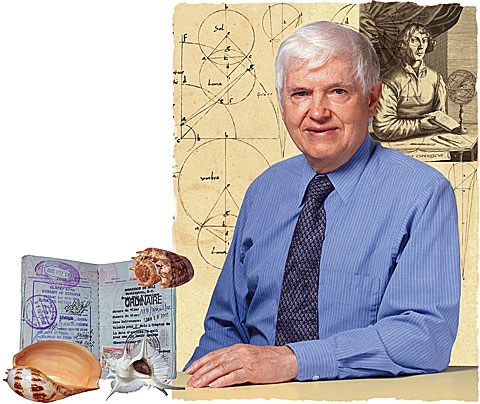 |
| Copernicus looks over the shoulder of Gingerich, who has spent decades chasing the great one's work and has now chronicled the hunt in a sprightly book. The hunter's passport, along with evidence, discovered in his office, of a fondness for gastropods. |
| Portrait and photographs of shells by Jim Harrison. Photomontage by Bartek Malysa |
Gingerich retired from teaching at the end of 1999 and took his farewell ride on the rocket cart at a reunion of former teaching fellows the next spring. But he is still obsessed by the book, as he has been for more than 30 years. It is the revolutionary work of Polish astronomer and cleric Nicolaus Copernicus, De revolutionibus orbium coelestium libri sex, literally "Six Books on the Revolutions of the Heavenly Spheres." Copernicus died soon after the book came off the press in 1543, but his magnum opus went on essentially to ignite the scientific revolution. It is usually referred to in the short form, De revolutionibus, and "Day revoluty-OWN-ibus" is a good approximation of its proper pronunciation, says Gingerich. Its title page reminds him of an optometrist's chart:
NICOLAUS CO
PERNICUS OF TORUN
ABOUT THE REVEOLUTIONS OF
the Heavenly Spheres in Six Books.
Copernicus argued against the conventional wisdom, promulgated by Claudius Ptolemy in Alexandria around A.D. 150, that the earth was fixed at the middle of the universe. He proposed instead that what could be observed of planetary motion could be explained if the sun was immovable in the middle, with the earth and other planets going around it, the modern understanding of the solar system.
But what about Holy Writ, in particular the passage from Joshua in which he commands the sun to stand still and the Lord listens and the sun does stand still in the middle of the sky for almost an entire day? An anonymous notice on the back of Copernicus's title page, addressed "To the Readers Concerning the Hypotheses in this Book," soothingly explains, says Gingerich, that "the ideas are merely hypothetical constructions for predicting the positions of planets and should not be assumed true or even probable." This advice to readers was written by Andreas Osiander, a theologian who finished the proofreading of Copernicus's book at the press in Nuremberg. The disclaimer may have done the trick, for the Catholic church withheld its condemnation of heliocentrism for many decades. It was left to the German astronomer Johannes Kepler to publish, in 1596, what Gingerich calls "an unabashedly heliocentric treatise." Galileo Galilei was also a believer in a sun-centered universe and came to famous confrontation with the Catholic church on its home ground by declaring such things as "the Bible teaches how to go to heaven, not how the heavens go."
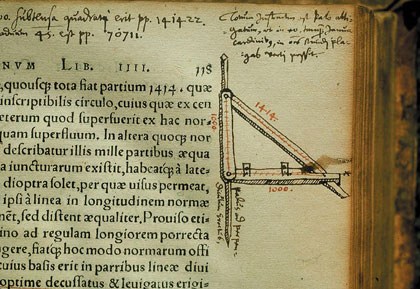 |
| Wilhelm Schickard annotated his copy of the first edition and drew a triquetrum, an instrument Copernicus describes. University of Basel Library. |
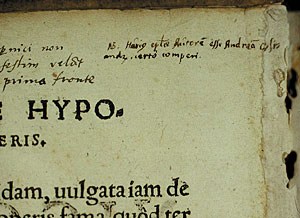 |
| Thomas Digges, the first Copernican in England, wrote on the title page of his copy of the second edition, "The common opinion errs." University of Geneva Library. |
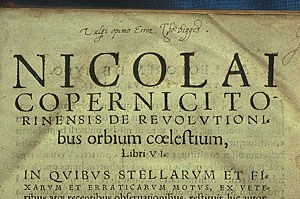 |
| In a minuscule hand, Michael Maestlin, a teacher of Kepler's, wrote in his first edition, concerning its anonymous advice to readers, "Now I am certain that this letter is by Andreas Osiander." Municipal Library, Schaffhausen, Switzerland. |
| Photographs courtesy of Owen Gingerich |
The novelist Arthur Koestler, in his 1959 best-selling history of early astronomy, The Sleepwalkers, called Copernicus's De revolutionibus, despite its earth-moving significance in the history of science, "the book that nobody read" and "an all time worst seller." Was Koestler right? How could one know? On a Saturday evening in October 1970, Gingerich and historian of science Jerry Ravetz rendezvoused in York, England. They were both on the committee to plan the Copernican Quinquecentennial in 1973, the five-hundredth anniversary of the great one's birth. They tried to make a list of likely readers of De revolutionibus. Georg Joachim Rheticus, Copernicus's only disciple, surely would have been one. So would Erasmus Reinhold, the top mathematical astronomer in Europe in the middle of the sixteenth century and the astronomy professor at Wittenberg. Proofreader Osiander was by definition a reader. Kepler; Michael Maestlin, Kepler's teacher at the University of Tübingen; and Tycho Brahe, the sixteenth-century Danish astronomer and instrument builder made the list. But it was a short list, nine names. Gingerich and Ravetz abandoned the effort and turned to admiring York's cathedral.
Then Gingerich went to Edinburgh. At the Royal Observatory, among a fabulous collection of rare astronomy books kept in two enormous steel cupboards, he came upon a first edition of De revolutionibus that was thoroughly annotated in the margins from beginning to end. (The margins of books of the period are wide, Gingerich believes, partly to provide space for annotations, which were typically in ink.)
Not only had this copy of the book been read, it had been read closely. By whom? Could it have been one of the nine men on the list made earlier? That would be too great a coincidence; there had to be at least 100 extant copies of the first edition, Gingerich reasoned (wrongly). But on the blind-stamped, pigskin binding, he found the date 1543 and the initials ER. Erasmus Reinhold?
"I seized a pencil and paper to make a rubbing of the dim impression," Gingerich recalls, "and to my dismay found not two, but three, initials: E.R.S." Poof went his hypothesis, he thought, but no. After a little study back in Cambridge, he soon discovered that E, R, and S were just the right initials for Erasmus Reinholdus Salveldiensis, "for in the sixteenth century a man's birthplacein this case Saalfeldwas a part of his formal designation." Gingerich obtained samples of Reinhold's handwriting, and indeed the annotations in the book were in his hand. Gingerich was to become adept not only at reading Renaissance Latin annotations, but at identifying the handwriting of a host of early modern astronomers.
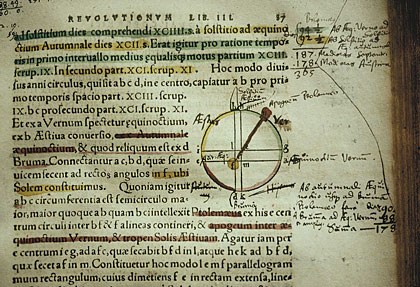 |
| This second edition's annotator in multicolor was Herwart von Hohenburg, a chancellor of Bavaria with an interest in astronomy. National Library of Russia, Moscow. |
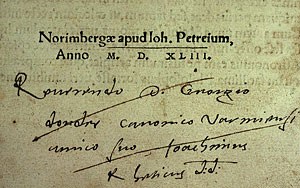 |
| The title page of the copy that launched Gingerich's odyssey: the first edition, annotated by Erasmus Reinhold, at the Royal Observatory, Edinburgh. |
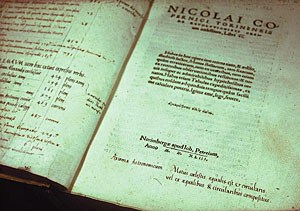 |
| Joachim Rheticus presented this first edition to Canon Georg Donder of the Frauenburg Cathedral, where Copernicus had been a canon. Uppsala University Library. |
| Photographs courtesy of Owen Gingerich |
Reinhold marked numerous errors throughout. Curiously, he had little to say, in the margins, about the hot-stuff heliocentric proposition advanced in the early, cosmological chapters, but commented enthusiastically on the dense and technical secondary matter in the rest of Copernicus's 400-page tome. If one copy of the book could yield such insights into the way a sixteenth-century astronomer reacted to "the most revolutionary scientific advance in more than a millennium," Gingerich asked himself, what would more copies of the book reveal?
He set out on a quest that he describes as a "dogged, adventurous, almost quixotic 30-year pursuit." The Edinburgh find "inaugurated my obsession to survey every surviving copy of Copernicus's book." After 10 years, Gingerich knew that Koestler was dead wrong. After 30, he could extensively document the book's impact on sixteenth-century scholars. The marginalia have much to say about how knowledge spread. They give evidence of what Gingerich calls the "invisible college," a network of tutorial and mentor relationships among astronomers that transcended institutional boundaries. His 400-page reference work, An Annotated Census of Copernicus' De Revolutionibus, published in 2002, meticulously describes each of the 276 copies of the first edition and 325 of the second, a reprint of 1566, that he had examined. Since the census appeared, one more copy of the first edition has surfaced and five more of the second.
Now a senior astronomer emeritus at the Smithsonian Astrophysical Observatory in Cambridge and research professor of astronomy and of the history of science at Harvard, Gingerich in the 1960s was a young astrophysicist publishing research papers with titles such as "Eleven-digit regular sexagesimals and their reciprocals" and beavering away with the observatory's computer on studies of solar spectra: "I was calculating the temperature and pressure in the outermost layers of the sun's atmosphere, maybe the outer 100 kilometers." In 1971, with three others, he produced a paper on that research, "The Harvard-Smithsonian Reference Atmosphere." "We included so many detailed tables of what was going on that nobody bothered to update the work. The study hung around for a long time and has had more than 500 literature citations," says Gingerich. "That was the last of the astrophysical papers I published."
In the decade before he became fully entangled in Copernicus, Gingerich "entered the magic circle of Johannes Kepler," the man who "forged the Copernican system as we know it" and is the hero of Koestler's The Sleepwalkers. Gingerich began lining out papers about Kepler: "Kepler as a Copernican" (1971), "Johannes Kepler and the Rudolphine Tables" (1971), "Johannes Kepler and the new astronomy" (1972). Kepler's quadricentennial came in 1971, two years before the Copernican quinquecentennial, which would greatly absorb Gingerich's time. "I sometimes say, with considerable truth," he says, "that my career in astrophysics was derailed by anniversaries." Later he adds, "I think the insights I have been bringing to the nature of science are more perceptive than anything I might have discovered by computing stellar atmospheres."
About his Copernican derailment, Gingerich now tells all. In January, Walker and Company will publish The Book Nobody Read: Chasing the Masterpiece of Nicolaus Copernicus. Gingerich the raconteur has produced a lively amalgam of scholarly detective story, Renaissance science history, academic memoir, and confessional. This reader of the manuscript, with not a jot of previous interest in Copernicus, found the book an unexpected delight and was sorry to come to the end of it. Gingerich could dine out on these stories for another three decades.
He begins chapter one in court, where he affirms to tell the truth. He is appearing as an expert witness to testify in the trial of a former seminary student accused of nicking a copy of De revolutionibus. Because Gingerich has seen every known copy of the book, he is able to identify this one as the stolen copy of the Franklin Institute in Philadelphia. Guilty as charged. Note to the deceitful: if you mean to steal, forge, or in any way interfere with an old book, pick a different title.
In explicating his guess about how many copies of the book were printed, he devotes much of a chapter to exploring how an early print shop worked and making a calculation, for starters, of how many copies the printer, Johannes Petreius, could have printed in the time allotted. Bottom line: print runs of 400 to 500 copies of the first edition, 500 to 550 of the second. If those estimates are correct, more than half the copies printed have survived.
He takes us to a 2001 Sotheby's auction in New York City where one of only about 20 copies of De revolutionibus remaining in private hands is on the block. "The auction had been under way barely half an hour when lot 34 flashed on the screen," he writes. "I set my stop watch. Did the bidding start at $100,000 or $200,000? I was too excited to remember, but the auctioneers say it was $150,000. I was later sorry that I hadn't registered for one of the numbered bidding paddles so that I could have made the first offer, even though I would have had to mortgage the house to back it up." The hammer price is $675,000; with Sotheby's fee on top of that, the anonymous telephone bidder is out about $750,000. Brace yourselves, book collectors: Gingerich writes that there are several of you impatiently waiting to spend a million dollars on a problem-free first edition Copernicus in an original sixteenth-century binding, preferably a copy with a known provenance and clear title.
Gingerich is agreeably digressive throughout his book. While telling of Copernicus's reluctance to publish his manuscript, for instance, he writes that one of the master's fears was that his ideas about the mobility of the earth would lead to his being hissed off the stage, and Gingerich offers this etymological aside: "That is precisely how he expressed it in the dedication that he eventually wrote to Pope Paul III. Copernicus uses the word explodendum, which means being hissed or clapped off the stage. The Oxford English Dictionary confirms that this is also the original but now obsolete meaning of the English word explode, which did not pick up the modern definition of 'to blow up with a loud noise' until around 1700. Shakespeare never used the word despite its theatrical connotation, but his contemporary Kepler did...."
Gingerich has packed his book with details, the preoccupation and passion of collectors. "I just assume there is such a thing as a collecting gene," he says. If so, he has it and it shapes his work. It also shapes his three-room suite of offices at the observatory, jammed with books, pictures, and the occasional seashell. Gingerich began collecting as a boyrocks. He moved on to postage stamps of the United States and Canada. Thence to rare astronomy books, "a lovely vice."
He began reading booksellers' catalogs long before he had enough money to buy anything. At the Observatory in his undergraduate days, as a summer helper to Harlow Shapley, "who was then probably the most famous astronomer in America," says Gingerich, he noticed a lot of old books on the shelves relating to French astronomer and comet hunter Charles Messier's Catalog of Nebulae and Star Clusters. "Many amateur astronomers were collectors of the nebulae and clusters in the sense of trying to find and see them all," he observes. In a bookseller's catalog, he noticed a volume of the Mémoires de l'Académie Royale des Sciences for 1771, realized that that was the volume in which Messier had published the first installment of his catalog, and bought it, his first rare astronomy book, for $11. He now specializes in ephemerides, books that give day-by-day positions of the planets. "For a lover of numbers," he writes, "these old volumes with their columns of digits have a compelling beauty, but this is essentially an eccentric's view." He does not have the world's largest collection of sixteenth- and seventeenth-century ephemerides, but only the second largest. The Bibliothèque Nationale in Paris has the first.
Gingerich also collects seashellsgastropods, single-shelled mollusksand in this he is joined by his wife, Miriam, who has been his companion as well on many book-hunting field trips. They have shells of about 1,500 species and harbor a particular interest in the Fusinus genus: spindle shells. There are roughly 150 species of spindle shell, and they have about 75. They're "working on" the genus and may someday make a scholarly contribution to its meager taxonomic literature.
The Gingerichs might also be said to collect the stamps of passport officials. They did an immense amount of traveling for Copernicus, but also absorbed an especially heavy barrage of stamps in the summer of 2002 when they spent six weeks in Africa on two tours, with the professor lecturing on the history of science and on astronomy. (A total eclipse of the sun was on one program; Gingerich has seen 12.) The couple are just back from Polynesia, where he lectured on Captain Cook and the transits of Venus.
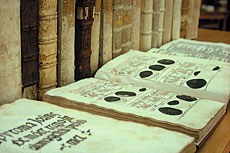 |
| Copernicus's library, University of Uppsala. |
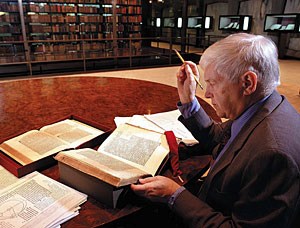 |
| At Yale's Beinecke Library, Gingerich examines what he calls, because of its annotations by Johannes Praetorius, the most important first edition in the United States. |
| Photographs courtesy of Owen Gingerich and Charles Eames |
Gingerich is a Mennonite. That affiliation led to his first trip across the seaand to Poland, no less, Copernicus's hauntswhen he was barely 16. A year after World War II, the United Nations Relief and Rehabilitation Administration sent thousands of horses to eastern Europe. The Brethren, one of the traditional peace churches, had a "Heifers for Relief" project, and cut a deal with the United Nations. If the UN would provide ships for the heifers, they would round up cowboys to escort the horses. Gingerich's father, at that time a history professor at a small Mennonite college in Kansas, was the supervisor of the trip and the main recruiter of the cowboys. The SS Stephen R. Mallory left Newport News in June 1946, with 847 horses on board, destined for farm duty in Poland, and 32 cowboys. Gingerich keeps his Merchant Marine seaman's card in a drawer of his desk.
He was born in Washington, Iowa, in 1930, and his family moved to central Kansas when he was 11. In 1947 his father took a teaching position at Goshen College in Indiana. Owen went directly to Goshen College and never graduated from high school. "Maybe," he says, "if The Book Nobody Read makes me famous, the Newton, Kansas, high school will award me an honorary degree."
Gingerich is a trustee of the John Templeton Foundation, an organization with roughly a $1-billion endowment that is much concerned with the interface of science and religion. He travels widely to speak on that topic. He has given a lecture in about 40 different venues entitled "Let There Be Light: Modern Cosmogony and Biblical Creation." "I call this my pro-Christian, anti-creationism lecture," he says. He spoke at a conference on "Science and Religion: Are They Compatible?" in Atlanta in 2001, jointly sponsored by the publisher of the Skeptical Inquirer and the Council for Secular Humanism. "I said I was plainly Daniel in the lion's den as their token theist. There was a nervous laugh that rippled across the audience when I said that, so I socked it to 'em."
Throughout most of the twentieth century, Gingerich says, the eleventh commandment for Mennonites was "Thou shalt not think about evolution." But he has been asked by the Mennonite publishing house to write a book on evolution for their constituency, and he hopes to write it, as well as a biography of Harlow Shapley. "I know exactly how I'm going to start the evolution book," he says, "with the six-fingered dwarfism of the Amish in Lancaster County, Pennsylvania. This is a genetic defect that produces six fingers on both hands, among a whole set of other obnoxious debilitations. There are about 70 known cases, and every case can be traced back genealogically through both the mother and the father to an Amish couple that came to America in 1750." Where is the God in that story? "You have to understand not that God is reaching in and creating the mutations, but that the universe is set up so that it will work this way. It has interesting theological ramifications, and I would try to outline what some of those are for the theologians to think about."
Christopher Reed is executive editor of this magazine.





